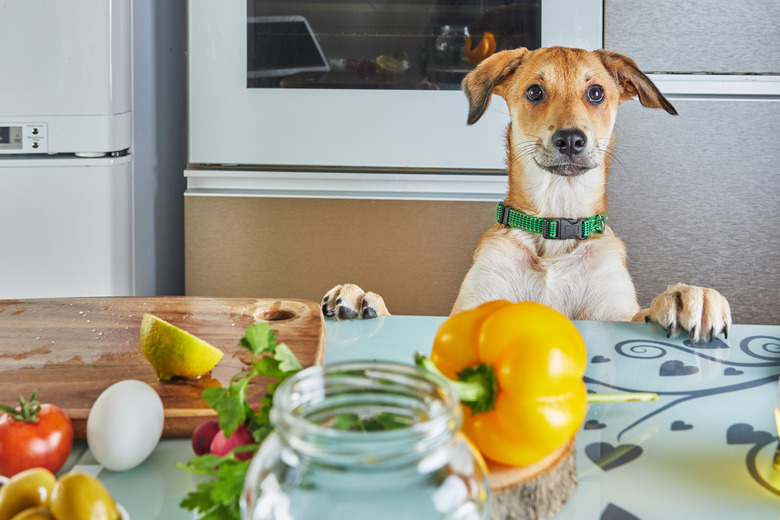How To Make Low-Protein Dog Food
We may receive a commission on purchases made from links.
Cuteness may earn compensation through affiliate links in this article.
There are a few reasons why a dog might benefit from a low-protein diet. These can be difficult to find in stores, so knowing how to make low-protein dog food at home can be a boon if your veterinarian has recommended it to treat your dog's condition. If your dog has a chronic condition such as kidney disease or a liver issue, feeding a low-protein diet will be a permanent change to your dog's daily nutrition.
Why feed low-protein dog food?
Why feed low-protein dog food?
If your dog has been diagnosed with an acute or chronic kidney disease, your vet may recommend a low-protein diet to help manage your dog's condition. The kidney works to eliminate wastes, and for a dog with kidney disease, protein is difficult to process. Lower protein in the diet appears to slow the progression of chronic kidney disease (CKD) by allowing the kidneys to work less to excrete protein waste products, explains VCA Hospitals. Though kidney disease is often irreversible, you can help improve your dog's quality of life through feeding him a specialized diet that you can make at home.
One less well-known reason to feed a low-protein dog food is that there is some evidence that reduced protein can help manage some behavioral issues. The Cummings Veterinary Medical Center at Tufts University says certain amino acids from food have been found to affect the flow of chemical signals through the neurotransmitters in the brain.neurotransmitter release and behavior can also be influenced through training or changes in routine. Some studies show that lower protein can help reduce problem such as territorial aggression.
Make low-protein dog food
Make low-protein dog food
A low-protein dog food is one that is considered to have 3.5 to 4.5 grams of protein for every 100 calories, although there is no legal definition or overall industry consensus on what exactly 'high' or low' protein foods are. Your veterinarian can help you make a determination on the best amount of protein for your dog based on what their medical or nutritional needs are.
Low-protein dog foods should include the following:
- higher amounts of fats – fish oil is a good source of healthy fats
- minimal amounts of phosphorus (it isn't clear why, but less phosphorus appears to delay the progression of CKD). Phosphorus is found in bones, cheese, fish with bones, egg yolks, and organ meat.
- broth, water, juice, and other liquids.
- moderate amounts of very high-quality protein (since they aren't getting much protein, make this nutrient count by providing high-quality sources).
Some items to avoid in a homemade low-protein dog food are polyunsaturated vegetable oils (safflower, sunflower, sesame, soybean, and corn oils).
The AKC says that low-protein foods your dog is likely to eat include sautéed egg whites (the yolks contain phosphorous which should be limited), pungent-smelling and -tasting cheeses, cottage and ricotta cheese, macaroni and cheese, pasta sprinkled with parmesan cheese, very small amounts of lean chicken, beef, or fish, grilled or baked, canned chicken chunks. If feeding hard-boiled eggs that contain the yolk, keep an eye on other sources of phosphorus. Serving several smaller meals rather than the usual two large means can also help.
Commercial low-protein dog foods
Commercial low-protein dog foods
If you're not sure how you can make a tasty low-protein meal for your dog, there are some commercially available options. Hill's Pet Prescription Diet Kidney Care dog food is made tasty with extra fat from pork and desirable ingredients that are known to trigger a dog's desire to eat. Hill's Prescription Diet Kidney Care dog food is also available in wet form in a can. Feeding a dog with kidney needs a wet food can help to ensure that they get all of the liquids they need, which is critical. The "S" in the name of Royal Canin Veterinary Diet Renal Support S Dry Dog Food stands for "savory," and this dog food is low in phosphorus and contains a potent blend of fats, oils and good protein levels.
Forza makes a Forza10 Nutraceutic Active Kidney Renal Support Diet Dry Dog Food that is made for dogs with renal failure and heart disease who can benefit from low protein, low phosphorus and low sodium. It also contains no potential allergens or additives such as corn, wheat, soy, by-product meals, GMOs or artificial ingredients.
Keep in mind that these nutritionally specific diets require a veterinarian's note to purchase; you will be asked to provide your pet and vet clinic information at checkout and your veterinarian will be contacted to confirm that the diet is one that is recommended for your pet. If you have a copy of your veterinarian's prescription, you can upload it at checkout to expedite the process.
In Conclusion
In Conclusion
If your vet tells you your dog needs a low-protein diet, it could be because your dog has been diagnosed with an acute or chronic kidney disease. Processing proteins makes the kidneys have to work harder to eliminate waste. Commercial low-protein dog foods are available but it is helpful to know what low-protein foods you can feed your dog on your own. A low-protein dog food is one that is considered to have 3.5 to 4.5 grams of protein for every 100 calories, although there is no legal definition or overall industry consensus on what exactly 'high' or low' protein foods are. Avoid foods high in phosphorus and sodium and increase high-quality fats.
Warning
Always consult with a vet before altering your pet's diet. Your vet might recommend supplements to round out your feeding regimen. Avoid feeding your dog treats unless they are vet-recommended to be low-protein, because they might add too much protein to your dog's diet.
References
- VCA Hospitals: Nutrition for Dogs With Chronic Kidney Disease
- Cummings Veterinary Medical Center at Tufts University: Behavior & Protein: Does Protein in Dog Food Play a Role in Your Dog's Behavior?
- AKC: Kidney Disease in Dogs: How Much Do You Know?
- Acme Canine: When Your Dog Needs A Low Protein Diet?


